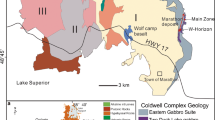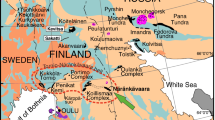Abstract
Potholes represent areas where the normally planar PGE-rich Merensky Reef of the upper Critical Zone of the Bushveld Complex transgresses its footwall, such geometric relationships being unusual in layered intrusions. The recognition of vertical dykes of Merensky pyroxenite in the footwall suggests downward collapse of crystal mush into pull-apart sites resulting from tensional deformation due to the loading effects of major new magma additions. In contrast, crosscutting anorthosite veins display physical and isotopic evidence of upward emplacement. The Merensky Reef and its footwall have distinct initial Sr-isotope ratios (R 0 > 0.7066 and <0.7066, respectively), which may be used to constrain these processes related to pothole formation. Merensky Reef in potholes (R 0 = 0.7069−0.7078) shows no isotopic evidence of assimilation of, or reaction with, footwall material. Discrete, discordant replacement bodies of anorthosite extend from the footwall lithologies to cross-cut the Merensky Reef and its hanging wall. The initial Sr-isotope ratio in these replaced rocks is totally reset to footwall values (R 0 = 0.7066), and immediately adjacent stratiform lithologies are slightly modified towards footwall values. In contrast, Neptunian pyroxenitic (Merensky) dykes cross-cutting the footwall lithologies, with a large surface area to volume ratio, and low Sr content, do not display footwall-like Sr-isotope initial-ratios (R 0 = 0.7077), and thus show no evidence for assimilation of or reaction with footwall material. Furthermore, pegmatoidal replacement pyroxenite (“replacement pegmatoid”), at the base of the Merensky Reef within potholes, has a high initial-ratio (R 0 > 0.7071), and so models of pervasive metasomatism by footwall material are not applicable. This isotopic evidence indicates that there was no active interaction of footwall material with the overlying magma during, or after, the formation of Merensky Reef potholes, a basic tenet of existing pothole formation hypotheses involving footwall mass-transfer. In contrast, the isotopic data are entirely consistent with an extensional model for pothole formation, with the more radiogenic Merensky magma migrating laterally to fill extensional zones in the footwall layers.
Similar content being viewed by others
Author information
Authors and Affiliations
Additional information
Received: 11 October 1997 / Accepted: 21 December 1998
Rights and permissions
About this article
Cite this article
Carr, H., Kruger, F., Groves, D. et al. The petrogenesis of Merensky Reef potholes at the Western Platinum Mine, Bushveld Complex: Sr-isotopic evidence for synmagmatic deformation. Mineral. Deposita 34, 335–347 (1999). https://doi.org/10.1007/s001260050208
Issue Date:
DOI: https://doi.org/10.1007/s001260050208




